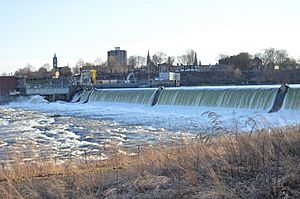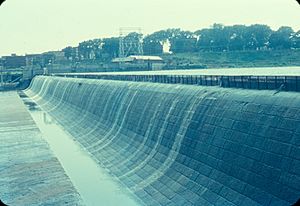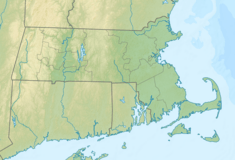Holyoke Dam facts for kids
Quick facts for kids Holyoke Dam |
|
|---|---|

Holyoke Dam during spring thaw
|
|
|
Location of Holyoke Dam in the western Massachusetts, USA
|
|
| Country | United States |
| Location | Hampden County and Hampshire County Massachusetts |
| Coordinates | 42°12′49″N 72°36′06″W / 42.21361°N 72.60167°W |
| Purpose | Power, regulation, industrial |
| Status | Operational |
| Construction began | 1895 |
| Opening date | 1900 |
| Construction cost | ≈$1,000,000 (1900) |
| Owner(s) | Holyoke Gas & Electric |
| Operator(s) | Holyoke Gas & Electric |
| Dam and spillways | |
| Type of dam | Granite gravity |
| Impounds | Connecticut River |
| Height (foundation) | 30 ft (33.5 ft while rubber bladder is inflated) |
| Length | 1,020 ft (310 m) |
| Elevation at crest | 94.6 ft (28.8 m) |
The Holyoke Dam, also known as the Hadley Falls Dam, is a large granite dam. It was built to create hydroelectric power. This means it uses the force of moving water to make electricity. The dam works with the Holyoke Canal System at Hadley Falls on the Connecticut River. It is located between the towns of Holyoke and South Hadley, Massachusetts.
The dam you see today is actually the third one built in this spot. The Holyoke Dam and its canal system are very important in engineering history. They are recognized as a Historic Mechanical Engineering Landmark. This is because of two major inventions linked to them. One is the Venturi meter, created by Clemens Herschel. This was the first tool that could accurately measure large amounts of water flow. The other is the McCormick-Holyoke Turbine, invented by John B. McCormick. This turbine was super efficient for its time, doubling how well turbines worked to over 80%.
Contents
Why Was the Holyoke Dam Built?

The Connecticut River between Holyoke and South Hadley had a natural drop in the water level. This drop was called the "Great Falls" and was about 53 feet high. It was located about 86 miles from the Atlantic Ocean.
In the mid-1800s, some investors saw how successful textile mills were in the city of Lowell, Massachusetts. They wanted to create a similar industrial city along the Connecticut River. In 1847, a representative named George C. Ewing found a good spot for this new city. He bought 1200 acres of land on the riverbank at Hadley Falls.
By 1848, the investors formed a company called the 'Hadley Falls Co.' They planned to build a new industrial city. Their first step was to build a dam across the Great Falls.
The First Dam: A Big Mistake!
The first dam was made of timber frames filled with rocks and rubble. It was built very quickly, in just a few months. When it was finished, the gates were closed to let the water build up behind it.
However, the dam was not built strongly enough. It wasn't properly attached to the riverbed. Soon after the gates closed, the dam started leaking badly. By 3:20 PM, the entire dam broke apart! A huge rush of water, logs, and debris crashed downstream. A worker quickly sent a telegram to the investors, saying, "3:20 p.m., your dam has gone to hell by way of Willimansett."
One person, Arthur E. Ferry, remembered seeing this event as a child in 1929. He described how people were walking in the riverbed after the water drained, looking for things. Then, they had to scramble to safety when the dam broke. He said it was a "frightful scene" with a massive amount of water and timbers rushing down.
The Second Dam: Learning from Problems
After the first dam failed, a second dam was built the very next year, in 1849. This dam was also made of wood. It helped Holyoke become a powerful industrial city in the 1800s.
But this second dam had its own problems. The fast-moving water pouring over the dam started to wear away the rocks underneath it. Also, the constant vibration from the waterfall caused doors and windows in nearby mills and homes to shake.
To fix some of these issues, a large timber and rock "apron" was added to the dam between 1868 and 1870. This helped reduce the vibrations. However, the way it was built still allowed the erosion of the rocks below to continue.
By 1884, people realized a much stronger, stone dam was needed. This new dam would solve the problems and make sure the city could keep using hydropower for a long time. Building such a large stone dam was a huge project. The wooden dam at that time was the second longest dam in the country! It took 11 years for construction to begin and nearly 16 years to finish.
The Dam Today: Built to Last
Construction on the third and current Holyoke Dam started in 1895. The very last stone was put in place on January 5, 1900.
During its construction, workers used a special narrow gauge railroad to move the heavy base stones. They also used what was then the longest cableway in the world. This cableway stretched across the Connecticut River, helping to move stones to the higher parts of the dam. This dam was built to be strong and has been operating ever since.




